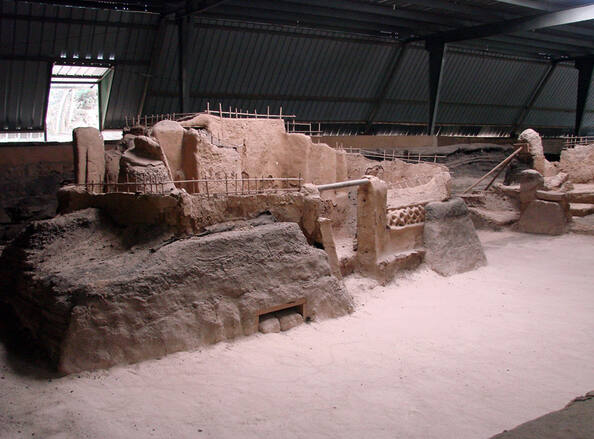Sitio arqueológico de Joya de Cerén
Joya de Cerén Archaeological Site
Joya de Cerén was a pre-Hispanic farming community that, like Pompeii and Herculaneum in Italy, was buried under an eruption of the Laguna Caldera volcano c. AD 600. Because of the exceptional condition of the remains, they provide an insight into the daily lives of the Central American populations who worked the land at that time.
Description is available under license CC-BY-SA IGO 3.0
Site archéologique de Joya de Cerén
Joya de Ceren était une communauté agricole préhispanique qui, comme Pompéi et Herculanum en Italie, fut brutalement engloutie par une éruption du volcan Laguna Caldera vers 600. Grâce à leur parfait état de conservation, ses vestiges témoignent de la vie quotidienne des cultivateurs mésoaméricains de l’époque.
Description is available under license CC-BY-SA IGO 3.0
موقع خويا دي سيرين الأثري
كانت خويا دي سيرين جماعةً زراعيّةً سالفةً للعصر الإسباني وقد طمرها فوران بركان لاغونا كاليدرا قرابة العام 600 ، تماماً كما حصل مع بومباي وهرقولانيوم في إيطاليا. وتجسّد البقايا الأثريّة المحافظ عليها بشكلٍ ممتاز الحياة اليوميّة لمزارعي الوسط الأمريكي في تلك الحقبة.
source: UNESCO/CPE
Description is available under license CC-BY-SA IGO 3.0
霍亚-德赛伦考古遗址
霍亚-德赛伦考古遗址是古拉丁美洲的一个农庄,像意大利的庞培和赫库兰尼姆一样,于公元600年左右遭到火山喷发掩埋。正是由于这种特殊的保存方式,使得人们现在可以从此了解当时在这块土地上耕作的中美洲人的日常生活。
source: UNESCO/CPE
Description is available under license CC-BY-SA IGO 3.0
Археологические памятники древнего поселения Хойя-де-Серен
Хойя-де-Серен был доиспанским сельским поселением, которое, подобно Помпее и Геркулануму в Италии, около 600 г. было погребено под вулканическими выбросами при извержении. Исключительно хорошее состояние его остатков позволяет получить представление о повседневной жизни населения Центральной Америки, занимавшегося в то время земледелием.
source: UNESCO/CPE
Description is available under license CC-BY-SA IGO 3.0
Sitio arqueológico de Joya de Cerén
Al igual que las ciudades romanas de Pompeya y Herculano, la comunidad agrícola prehispánica de Joya de Cerén fue repentinamente sepultada por una erupción del volcán Laguna Caldera hacia el año 600. Gracias a su perfecto estado de conservación, los vestigios de este sitio aportan un testimonio excepcional sobre la vida cotidiana de los agricultores mesoamericanos de esa época.
source: UNESCO/CPE
Description is available under license CC-BY-SA IGO 3.0
ホヤ・デ・セレンの古代遺跡
source: NFUAJ
Archeologisch gebied Joya de Cerén
Joya de Cerén was een pre-Spaanse agrarische gemeenschap die – net als Pompeii en Herculaneum in Italië – werd bedolven onder een uitbarsting van een vulkaan, de Laguna Caldera omstreeks 590 na Christus. Er is waarschijnlijk een waarschuwende aardbeving geweest die de bewoners de tijd gaf om te vluchten. De as heeft hun persoonlijke bezittingen bewaard, van tuingereedschap en potten gevuld met potten, tot slaapmatten en religieuze artikelen. In wezen is het agrarisch dorp ‘bevroren’ in de tijd. De uitzonderlijke staat van de overblijfselen geven inzicht in het dagelijks leven van de Midden-Amerikaanse volkeren, die op dat moment landbewerkers waren.
Source: unesco.nl
